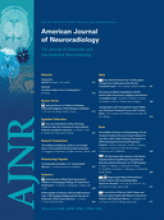Research ArticleBrain
Permeability Estimates in Histopathology-Proved Treatment-Induced Necrosis Using Perfusion CT: Can These Add to Other Perfusion Parameters in Differentiating from Recurrent/Progressive Tumors?
R. Jain, J. Narang, L. Schultz, L. Scarpace, S. Saksena, S. Brown, J.P. Rock, M. Rosenblum, J. Gutierrez and T. Mikkelsen
American Journal of Neuroradiology April 2011, 32 (4) 658-663; DOI: https://doi.org/10.3174/ajnr.A2378
R. Jain
J. Narang
L. Schultz
L. Scarpace
S. Saksena
S. Brown
J.P. Rock
M. Rosenblum
J. Gutierrez

References
- 1.↵
- Cheronov M,
- Hayashi M,
- Izawa M,
- et al
- 2.↵
- Graves EE,
- Nelson SJ,
- Vigneron DB,
- et al
- 3.↵
- Kumar AJ,
- Leeds NE,
- Fuller GN,
- et al
- 4.↵
- 5.↵
- Langleben DD,
- Segall GM
- 6.↵
- Covarrubias DJ,
- Rosen BR,
- Lev H
- 7.↵
- Jain R,
- Scarpace L,
- Ellika S,
- et al
- 8.↵
- Cha S,
- Lupo JM,
- Chen MH,
- et al
- 9.↵
- Hu LS,
- Baxter LC,
- Smith KA,
- et al
- 10.↵
- Ellika SK,
- Jain R,
- Patel SC,
- et al
- 11.↵
- Law M,
- Yang S,
- Babb JS,
- et al
- 12.↵
- Sorensen AG,
- Batchelor TT,
- Zhang WT,
- et al
- 13.↵
- Barajas RF Jr.,
- Chang JS,
- Segal MR,
- et al
- 14.↵
- Hazle JD,
- Jackson EF,
- Schomer DF,
- et al
- 15.↵
- Jain R,
- Ellika SK,
- Scarpace L,
- et al
- 16.↵
- Hopewell JW,
- Wright EA
- 17.↵
- Zhao W,
- Diz DI,
- Robbins ME
- 18.↵
- 19.↵
- 20.↵
- 21.↵
- Kamiryo T,
- Lopes MB,
- Kassell NF,
- et al
- 22.↵
- 23.↵
- Rubin P,
- Gash DM,
- Hansen JT,
- et al
- 24.↵
- Cao Y,
- Tsien CI,
- Sundgren PC,
- et al
- 25.↵
- Lee MC,
- Cha S,
- Chang SM,
- et al
- 26.↵
- 27.↵
- Barajas RF,
- Chang JS,
- Sneed PK,
- et al
- 28.↵
- Jain R,
- Gutierrez J,
- Narang J,
- et al
- 29.↵
- Nordal RA,
- Nagy A,
- Pintilie M,
- et al
- 30.↵
- Gonzalez J,
- Kumar AJ,
- Conrad CA,
- et al
- 31.↵
- 32.↵
- Gaensler EH,
- Dillon WP,
- Edwards MS,
- et al
In this issue
Advertisement
R. Jain, J. Narang, L. Schultz, L. Scarpace, S. Saksena, S. Brown, J.P. Rock, M. Rosenblum, J. Gutierrez, T. Mikkelsen
Permeability Estimates in Histopathology-Proved Treatment-Induced Necrosis Using Perfusion CT: Can These Add to Other Perfusion Parameters in Differentiating from Recurrent/Progressive Tumors?
American Journal of Neuroradiology Apr 2011, 32 (4) 658-663; DOI: 10.3174/ajnr.A2378
0 Responses
Permeability Estimates in Histopathology-Proved Treatment-Induced Necrosis Using Perfusion CT: Can These Add to Other Perfusion Parameters in Differentiating from Recurrent/Progressive Tumors?
R. Jain, J. Narang, L. Schultz, L. Scarpace, S. Saksena, S. Brown, J.P. Rock, M. Rosenblum, J. Gutierrez, T. Mikkelsen
American Journal of Neuroradiology Apr 2011, 32 (4) 658-663; DOI: 10.3174/ajnr.A2378
Jump to section
Related Articles
- No related articles found.
Cited By...
- Differentiation between Treatment-Induced Necrosis and Recurrent Tumors in Patients with Metastatic Brain Tumors: Comparison among 11C-Methionine-PET, FDG-PET, MR Permeability Imaging, and MRI-ADC--Preliminary Results
- Histogram Analysis of Intravoxel Incoherent Motion for Differentiating Recurrent Tumor from Treatment Effect in Patients with Glioblastoma: Initial Clinical Experience
- Perfusion CT Imaging of Brain Tumors: An Overview
This article has not yet been cited by articles in journals that are participating in Crossref Cited-by Linking.
More in this TOC Section
Similar Articles
Advertisement











